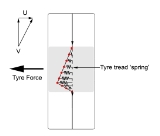
Cornering force
Encyclopedia

Force
In physics, a force is any influence that causes an object to undergo a change in speed, a change in direction, or a change in shape. In other words, a force is that which can cause an object with mass to change its velocity , i.e., to accelerate, or which can cause a flexible object to deform...
produced by a vehicle tire
Tire
A tire or tyre is a ring-shaped covering that fits around a wheel rim to protect it and enable better vehicle performance by providing a flexible cushion that absorbs shock while keeping the wheel in close contact with the ground...
during cornering.
Cornering force is generated by tire slip
Slip (vehicle dynamics)
In vehicle dynamics, slip is the relative motion between a tire and the road surface it is moving on. This slip can be generated either by the tire's rotational speed being greater or less than the free-rolling speed , or by the tire's plane of rotation being at an angle to its direction of...
and is proportional to slip angle
Slip angle
In vehicle dynamics, slip angle or sideslip angle is the angle between a rolling wheel's actual direction of travel and the direction towards which it is pointing...
at low slip angles. The rate at which cornering force builds up is described by relaxation length
Relaxation length
Relaxation length is a dynamic property of pneumatic tires that describes the delay between when a slip angle is introduced and when the cornering force reaches its steady-state value....
. Slip angle describes the deformation of the tire contact patch
Contact patch
Contact patch is the portion of a vehicle's tire that is in actual contact with the road surface. It is most commonly used in the discussion of pneumatic tires, , where the term is strictly used to describe the portion of the tire’s tread that touches the road surface...
, and this deflection
Deflection (engineering)
In engineering, deflection is the degree to which a structural element is displaced under a load. It may refer to an angle or a distance.The deflection distance of a member under a load is directly related to the slope of the deflected shape of the member under that load and can be calculated by...
of the contact patch deforms the tire in a fashion akin to a spring
Spring (device)
A spring is an elastic object used to store mechanical energy. Springs are usually made out of spring steel. Small springs can be wound from pre-hardened stock, while larger ones are made from annealed steel and hardened after fabrication...
.
As with deformation of a spring, deformation of the tire contact patch generates a reaction force
Reaction (physics)
The third of Newton's laws of motion of classical mechanics states that forces always occur in pairs. Every action is accompanied by a reaction of equal magnitude but opposite direction. This principle is commonly known in the Latin language as actio et reactio. The attribution of which of the two...
in the tire; the cornering force. Integrating
Integral
Integration is an important concept in mathematics and, together with its inverse, differentiation, is one of the two main operations in calculus...
the force generated by every tread element along the contact patch length gives the total cornering force. Although the term, "tread element" is used, the compliance in the tire that leads to this effect is actually a combination of sidewall deflection and deflection of the rubber
Rubber
Natural rubber, also called India rubber or caoutchouc, is an elastomer that was originally derived from latex, a milky colloid produced by some plants. The plants would be ‘tapped’, that is, an incision made into the bark of the tree and the sticky, milk colored latex sap collected and refined...
within the contact patch. The exact ratio of sidewall compliance to tread compliance is a factor in tire construction and inflation pressure.
The diagram is misleading because the reaction force would appear to be acting in the wrong direction. It is simply a matter of convention
Convention (norm)
A convention is a set of agreed, stipulated or generally accepted standards, norms, social norms or criteria, often taking the form of a custom....
to quote positive cornering force as acting in the opposite direction to positive tire slip so that calculations are simplified, since a vehicle cornering under the influence of a cornering force to the left will generate a tire slip to the right.
The same principles can be applied to a tire being deformed longitudinally, or in a combination of both longitudinal and lateral directions. The behaviour of a tire under combined longitudinal and lateral deformation can be described by a Traction Circle.

